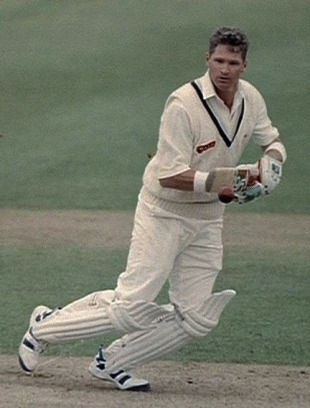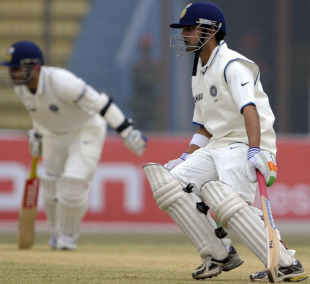Whose call is it anyway?
Backing up, calling right, rotating the strike, stealing singles, and avoiding run-outs: running between wickets is a skill in its own right
July 15, 2010

| ||
| Related Links | ||
When Herschelle Gibbs dropped a catch off Steve Waugh in the 1999 World Cup Super Sixes match, it felt like he had dropped the cup. In fact, Waugh apparently said as much to Gibbs. The slip-up cost South Africa the game, but it was another error that sealed their fate. A horrible mix-up between Lance Klusener and Alan Donald, while attempting the run to win the semi-final, led to Australia's entry into the final.
Running between the wickets has been a part of cricket since the game's inception. Yet, for a long time it was considered a mediocre player's way of getting the scoreboard to tick along, for good batsmen found the fence easily. Not enough importance was given to this aspect of the game till the shorter version made its presence felt. Unlike five-day cricket, in the limited-overs game, captains don't employ attacking fields throughout the day, so taking singles to rotate strike is almost mandatory to keep the scoreboard moving. So much so that a number of one-day specialists built their games around taking singles: Michael Bevan, Ajay Jadeja, Robin Singh, to name a few. These were extremely fit men, who took sadistic pleasure in testing the fitness levels of the opposition.
I first learned about the importance of this facet of the game by watching Dean Jones. There may have been others before him who were really good at it, but to my young, impressionable mind, it was Jones who revolutionised running between the wickets. For me, he ticked all the boxes one must to be an efficient runner. That's when I realised that running between the wickets is as much an art as it is a skill.
Backing up
Contrary to popular belief, running between the wickets starts at the non-striker's end. Of course, the striker knows best how hard and how far from the fielder he has hit the ball, and being in motion already, he finds it easy to make a move. While the striker knows, the non-striker assumes, and tries to make up for the lack of information by taking a start to gain momentum.
The ideal time for the non-striker to start moving is after the bowler lands his back foot in his bowling stride. After which he should back up only to the point from where he can return easily if required. The bat should always be held in the hand closest to the bowler.
Calling
As a kid, I was taught that the striker must call when he has hit the ball in front of the stumps. Everything hit behind the stumps was considered the non-striker's call; the reason being, the non-striker has a good view of a ball hit behind the stumps.
Unfortunately, this is as wrong as it can possibly get. It's natural for the batsman to look in the direction of the shot he has played, and hence he is in a better position to know the angles. So, even if the ball goes behind the striker, it's his call. The non-striker rarely has accurate information. From his vantage point, he can never be certain if the ball is going slightly to the left or right of the fielder or straight to him. The striker knows how much power he put behind the shot, the angles involved, and the realistic chance of rotating strike.
But there are moments when the striker can't see the ball at all: when the ball goes to the wicketkeeper and he fumbles, or when the ball hits the striker's pads and he isn't sure where it went. That's when the non-striker must chip in. Also, the non-striker has the right to say no.
Virender Sehwag is the ideal non-striker in this scenario. He's always looking for cheeky singles. He believes that if the keeper has to dive to the side, it's an opportunity to cross over, since the keeper will need time to get up, remove his gloves and throw.
| Speed is overrated in running between the wickets. It's more about your awareness and judgement with regards to the power with which you hit the ball and the ability of the fielder | |||
Turning and sliding
Everyone knows that the shortest distance between two points is a straight line, but lots of batsmen don't following the rule when turning for a second or third run. Surprisingly, Jonty Rhodes was among these players. Instead of touching down and turning on the spot, he would go around in a small arc at the end. But then he had the speed to make up for it.
If you're not as quick as him, you're better off making a tight turn. And while turning for the second or third run, keep an eye on the ball and make sure you switch the bat from one hand to the other to do this effectively if you need to. A matter of seconds can be the difference between a good run and a run-out. Turning blindly costs you those micro-seconds and it might also cost you your wicket.
Jones impressed me with the way he ran only as much as he absolutely needed to. He would hold the bat high on the handle so as to use its length to the optimum, and while turning, he would stay low and stretch fully. While staying low helped him generate the necessary thrust to turn quickly and gain momentum again, stretching the arms and the body allowed him to run at least one step fewer.
Everyone knows you should always slide the bat into the crease, but it's important to remember to slide either the face or the edge of the bat. Earlier, coaches believed it was best to use only the edge, but considering the bat sometimes gets stuck that way, the approach has changed. Another benefit of having the bat face the ground is that when you dive to make the crease, the bat stays grounded. If you try diving in with the back of the bat facing down, the curve of the blade sometimes leaves vital inches in the air.
Also, one must not forget the importance of staying off the business area of the pitch at all times. The only exception to this rule is when you have to come in the way of a throw to avoid getting run-out.
Judgement, rapport, strategy
Speed is overrated in running between the wickets. Yes, you need to be quick to get to the other end but a good sprinter may not necessarily be a good runner between wickets. It's more about your awareness and judgement with regards to the power with which you have hit the ball and the ability of the fielder.
But it always starts with the intent. Both Gautam Gambhir and Viru are good examples here - though, while you have to give them full marks for intent, their judgement can be questioned at times. The person who rarely gets it wrong in judging is Sachin Tendulkar. Invariably he knows how many runs are available right from the moment he hits the ball. You will rarely see him huffing and puffing or diving to make his ground.
In many instances there are only one-and-a-half or two-and-a-half runs available. That's when good runners put pressure on the fielder. MS Dhoni is excellent at this. He's extremely quick between the wickets and uses that speed to steal an extra run whenever possible.
Since, calling is based on judgment, the moment it isn't spot-on, you're in a spot. At times the striker takes the non-striker's running skills into account before calling for a run, which invariably leads to disaster.
Misunderstandings also occur often, especially in loud and noisy stadia. It's almost impossible to hear each other through the din, so one reacts on instinct and based on faith in one's partner. This is where knowing the other person well helps. No wonder Gauti and Viru are good friends off the field too.

| ||
| | ||
Good runners either know or decide among themselves in advance the path in which they will be running. Ideally, the striker should run down the off side channel and the non-striker on the leg side, but it changes if the bowler goes around the stumps or if a left-hander bowls over the stumps to a right-hand batsman or vice versa. In such cases it's the non-striker who gives way to the striker and runs further away from the stumps.
Dealing with a substitute runner is also a challenge. The rule here is that it's always the striker's call and the substitute must not assume anything but only react to the call and respond appropriately. Problems happen when the substitute starts calling from square leg and the non-striker doesn't know where to look.
Running as a weapon
Stealing a single right under the nose of a fielder, especially a good one, is a kick. At times you stretch the envelope too much, test a good fielder, punt and fall short. Sehwag, though a good runner, is often guilty of running himself out, even in Test matches.
Both he and I took a lot of pride in running the Australians tired in the 2003-04 series. We hadn't decided beforehand that taking singles would be the strategy to ruffle them. In fact, Viru is always eager to get on and off strike, and for me, singles were the lifeline against disciplined bowling.
It started when we ran a single in the first Test in Brisbane. The fielder at gully threw a lobbed ball to the man at point. Since the ball hadn't reached the keeper, it wasn't dead. We sensed an opportunity and ran.
There's nothing a bowler hates more than leaking singles. He doesn't mind getting hit for fours because he knows he bowled a bad ball, but going for runs on good balls irks him big time. Also, if the strike is rotated, it means he has to bowl to a different batsman each time, which means he can't plan a dismissal.
You need to be a little cheeky too. I remember Ajay Jadeja once running when the striker was caught at slip off a no-ball. The fielder threw the ball in the air to celebrate without realising it was a no-ball. Jadeja was more aware and stole a single.
With the margin of victory getting smaller in the shorter formats, and captains opting for defensive field positions in Test cricket, running between the wickets has become ever so crucial.
Get a new e-mail account with Hotmail - Free. Sign-up now.
ha, I am going to experiment my thought, your post bring me some good ideas, it's truly amazing, thanks.
ReplyDelete- Norman